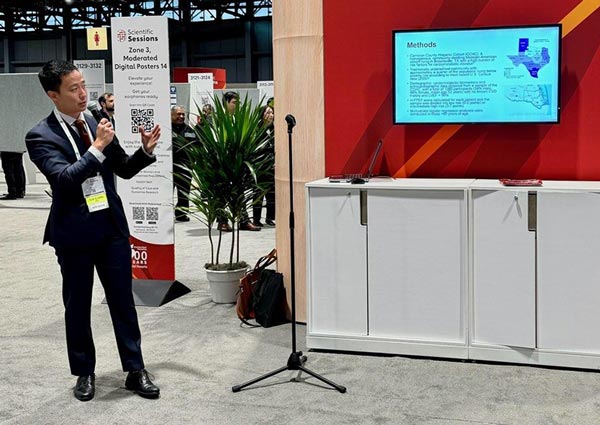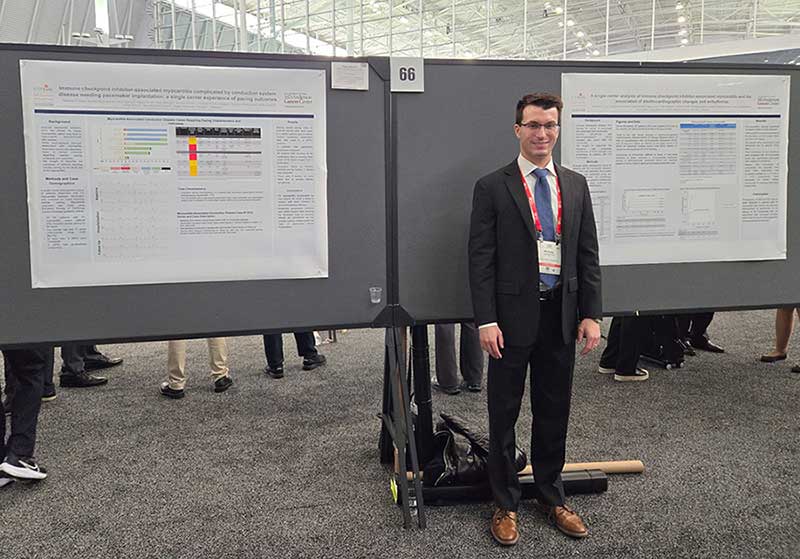Research Newsletter Archive
Spotlight on PGY6 Dr. Andrew Kim
 Heart failure with preserved ejection fraction (HFpEF) is increasingly being recognized as a leading cause of heart failure-related hospitalization and death, with its impact projected to exceed that of heart failure with reduced ejection fraction (HFrEF) over the coming years in part due to an aging population. The treatment has been challenging by a dearth of proven therapies and its overlap with other clinical syndromes, as well as a historical lack of diagnostic criteria. Existing research on heart failure among Hispanics have shown a rather high prevalence of cardiac dysfunction on echocardiography with only a minority of such cases resulting in overt clinical heart failure, as well as a younger median age of hospitalization for HFpEF compared to their non-Hispanic white counterparts.
Heart failure with preserved ejection fraction (HFpEF) is increasingly being recognized as a leading cause of heart failure-related hospitalization and death, with its impact projected to exceed that of heart failure with reduced ejection fraction (HFrEF) over the coming years in part due to an aging population. The treatment has been challenging by a dearth of proven therapies and its overlap with other clinical syndromes, as well as a historical lack of diagnostic criteria. Existing research on heart failure among Hispanics have shown a rather high prevalence of cardiac dysfunction on echocardiography with only a minority of such cases resulting in overt clinical heart failure, as well as a younger median age of hospitalization for HFpEF compared to their non-Hispanic white counterparts.

Dr. Kim presenting his work at the AHA Scientific session, held in November 2024 in Chicago, Illinois.
Mentors:Dr. Susan Laing and Dr. Soumya Patnaik
The study included over 1200 patients who underwent routine echocardiography over a decade, excluding those with reduced left ventricular ejection fraction (<50%) as well as co-morbid cardiovascular disease. Using the H2FPEF score, both echocardiographic parameters and clinical data were utilized to quantify the prevalence of sub-clinical HFpEF among the participants. Subjects were then stratified based on score into categories of low and intermediate-high risk, as well as by age. Several key findings were identified. Approximately half the patients in the study cohort were found to be at increased risk for HFpEF based on the H2FPEF score. Among young patients (<60 years old), the metabolic syndrome (as determined by the standard criteria for hypertension, dyslipidemia, waist circumference, and hyperglycemia) was found to be a significant risk factor for the development of HFpEF in this population, even after adjusting for co-variates such as body mass index. Based on these findings, Dr Kim et al concluded that the previously clinically validated H2FPEF score is a simple and useful tool to help identify those in this ethnic group at risk for HFpEF.
Since Hispanics represent a rapidly growing ethnic group in the United States, with most recent US Census data projecting representation of over 20% of the US population by the year 2030, this is a very important study to help identify high-risk groups for early initiation of preventive and life-saving therapies before transition to symptomatic HF.
Spotlight on Nicholas King, MD
Posters: Immune Checkpoint Inhibitor-associated Myocarditis Complicated By Conduction System Disease Needing Pacemaker Implantation: A Single Center Experience Of Pacing Outcomes
A Single Center Analysis Of Immune Checkpoint Inhibitor-associated Myocarditis And The Association Of Electrocardiographic Changes And Arrhythmias

Dr King presenting his posters simultaneously at HRS 2024
Publication: JACC case reports: https://www.jacc.org/doi/10.1016/j.jaccas.2024.103187
Mentor: Dr. Nicolas Palaskas
Summary: Dr King’s research focused on changes in the cardiac conduction system caused by immune checkpoint inhibitor (ICI) induced myocarditis. ICI’s represent a paradigm shift in cancer therapy by unleashing the immune system to fight malignancies. However, the complication of the immune activation can be severe bystander organ dysfunction including the heart. ICI induced myocarditis is rare but caries a high mortality. While conduction system disease is frequently associated with ICI myocarditis, the risk and outcomes of severe ICI myocarditis associated conduction disease is unknown. Dr King and his team looked at the cohort of patients at MD Anderson cancer center who had confirmed ICI myocarditis to see what EKG changes they had and specifically what the long-term outcomes were and identified those with severe conduction disease requiring pacing. They found that ICI myocarditis increased the risk of arrhythmias and AV block, and that for patients who developed complete heart block, the pacing need was minimal after the acute myocarditis period. Therefore, they concluded that conduction disease associated with ICI myocarditis can be treated with temporary supportive pacing while the myocarditis is treated and is likely to resolve as the myocarditis resolves.